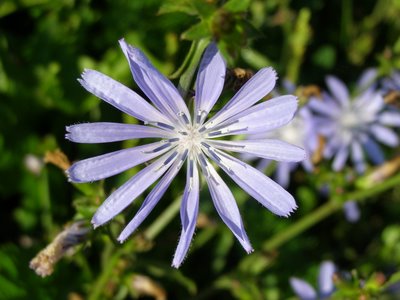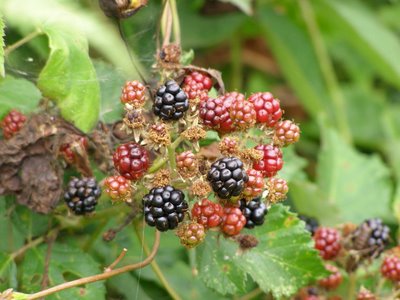The Piranhas, Aggressive Predator
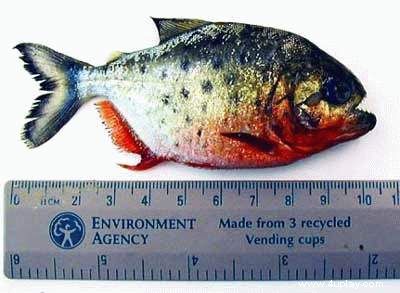 The piranhas or pirañas are a group of carnivorous freshwater fish living in South American rivers. They belong to five genera of the subfamily of Serrasalminae (which also includes closely related herbivorous fish including pacus and silver dollars). They are normally about 15 to 25 cm long (6 to 10 inches), although reportedly individuals have been found up to 40 cm in length. They are known for their sharp teeth (able to bite through a steel fishing hook) and an aggressive appetite for meat and flesh. They are normally only found in the Amazonian, Guianas and Paraguayan river systems. However, piranha (most likely former aquarium-dwellers) are also occasionally found in the Potomac River, but they typically do not survive the cold winters of that region.
The piranhas or pirañas are a group of carnivorous freshwater fish living in South American rivers. They belong to five genera of the subfamily of Serrasalminae (which also includes closely related herbivorous fish including pacus and silver dollars). They are normally about 15 to 25 cm long (6 to 10 inches), although reportedly individuals have been found up to 40 cm in length. They are known for their sharp teeth (able to bite through a steel fishing hook) and an aggressive appetite for meat and flesh. They are normally only found in the Amazonian, Guianas and Paraguayan river systems. However, piranha (most likely former aquarium-dwellers) are also occasionally found in the Potomac River, but they typically do not survive the cold winters of that region.From the moment tiny baby piranhas hatch from their microscopic eggs, they come into the world armed and dangerous. Baby piranha will feast on tiny crustaceans, fruits, seeds, and aquatic plants. Once they reach about 1.5 inches in length they begin feeding on the fins and flesh of other fish that wander too closely. As they grow larger they begin to venture out in groups (schools) of about 20 fish where they use a variety of hunting strategies to kill and eat their prey. Heck, they don't kill their prey first, they just start eating the victim alive - that's what makes them so ferocious. Adult piranha have been known to eat their own babies. Talk about brutal!
When a school of piranha are in a feeding frenzy the water appears to boil and churn red with blood. They attack with such ferocity that they strip an animal of its flesh within a matter of minutes, even taking bites out of each other in the process. Adult piranha will eat just about anything - other fish, sick and weakened cattle, even parts of people. Sickly cattle that have stooped their heads down to drink from the river have been grabbed by the mouth and nose and pulled into the water, completely devoured minutes later. As wicked as it all sounds, piranha have a useful function in the Amazonian jungles just like any other predators in the wild. They are part of the checks and balances Mother Nature employs to eliminate the weak and sick so only the strong survive.
Piranhas are world-famous for their razor-sharp teeth. Native peoples of South America will catch the piranha and use their teeth to make tools and weapons. Even the fisherman who catch these vicious little predators have to be careful when the fish is out of water. A single piranha out of water is still dangerous enough to take off the flesh, or the odd toe, from an unwary fisherman.

But, piranhas generally pose no threat to humans. Natives frequently swim in piranha-infested water without attacks or scratches. However, it is not recommended to swim where piranha live in drought season because of increased aggressiveness caused by food scarcity and increased tendency to form large schools. Piranha fish also have the same sensory system that enables sharks to detect blood in minuscule amounts, so it is believed that swimming with an open cut may enhance the chance of an attack, yet Piranha fish rarely try to eat animals much larger than themselves.
Ash Cloud from Mount Ubinas, Peru
This oblique image (looking at an angle) from the International Space Station (ISS) captures an ash cloud first observed on satellite imagery at 11:00 GMT on August 14, 2006. An ISS astronaut took this picture one hour and 45 minutes later. The ash cloud caused the Buenos Aires Volcanic Ash Advisory Center to issue an aviation hazard warning. Minor to moderately explosive eruptions of ash and pumice characterize modern activity at Ubinas. Pumice and ash blanket the volcanic cone and surrounding area, giving this image an overall gray appearance. Shadowing of the western flank of Ubinas throws several lava flows into sharp relief, and highlights the steep slopes at the flow fronts—common characteristics of thick, slow-moving lavas. The most recent major eruption of Ubinas occurred in 1969, although its historical record of activity extends back to the 16th century.
Astronaut photograph ISS013-E-66488 was acquired August 14, 2006, with a Kodak 760C digital camera using an 800 mm lens, and is provided by the ISS Crew Earth Observations experiment and the Image Science & Analysis Group, Johnson Space Center. The image in this article has been cropped and enhanced to improve contrast. Lens artifacts have also been removed. The International Space Station Program supports the laboratory to help astronauts take pictures of Earth that will be of the greatest value to scientists and the public, and to make those images freely available on the Internet. Additional images taken by astronauts and cosmonauts can be viewed at the NASA/JSC Gateway to Astronaut Photography of Earth.
Micro Scale Videos - Bugs Vs. Machines
 (Courtesy Sandia National Laboratories, SUMMiTTM Technologies, www.mems.sandia.gov)
(Courtesy Sandia National Laboratories, SUMMiTTM Technologies, www.mems.sandia.gov)1906, The San Francisco Earthquake, Nature's Dark Side
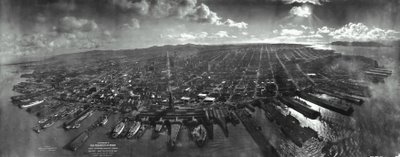
Click here for this beautiful high res photo.
The San Francisco earthquake of 1906 was a major earthquake that struck San Francisco and the coast of northern California at 5:12am on Wednesday, April 18, 1906. The most widely accepted magnitude for the earthquake is a moment magnitude (Mw) 7.8; however, other values have been proposed from 7.7 to as high as 8.3. The mainshock epicenter occurred offshore about 2 miles (3 km) from the city. It ruptured along the San Andreas Fault both northward and southward for a total length of 296 miles (477 km). Shaking was felt from Oregon to Los Angeles, and inland as far as central Nevada. The earthquake and resulting fire would be remembered as one of the worst natural disasters in the history of the United States, comparable in devastation to the Galveston Hurricane of 1900 and Hurricane Katrina in 2005.
 At the time, only 567 deaths were reported; the figure was concocted by government officials who felt that reporting the true death toll would hurt real estate prices and efforts to rebuild the city. Also, hundreds of casualties in Chinatown went ignored and unrecorded due to racism at the time. Today, this figure has been revised to a conservative estimate of at least 13,000, though some estimates have put it as high as 27,000 deaths. Most of the deaths occurred in San Francisco itself, but 189 were reported elsewhere across the San Francisco Bay Area. Other places in the Bay Area such as Santa Rosa, San Jose, and Stanford University also suffered severe damage. Between 225,000 and 300,000 people were left homeless out of a population of about 410,000; half of the refugees fled across the bay to Oakland. Newspapers at the time described Golden Gate Park, the Presidio, the Panhandle, and the beaches between Ingleside and North Beach being covered with makeshift tents.
At the time, only 567 deaths were reported; the figure was concocted by government officials who felt that reporting the true death toll would hurt real estate prices and efforts to rebuild the city. Also, hundreds of casualties in Chinatown went ignored and unrecorded due to racism at the time. Today, this figure has been revised to a conservative estimate of at least 13,000, though some estimates have put it as high as 27,000 deaths. Most of the deaths occurred in San Francisco itself, but 189 were reported elsewhere across the San Francisco Bay Area. Other places in the Bay Area such as Santa Rosa, San Jose, and Stanford University also suffered severe damage. Between 225,000 and 300,000 people were left homeless out of a population of about 410,000; half of the refugees fled across the bay to Oakland. Newspapers at the time described Golden Gate Park, the Presidio, the Panhandle, and the beaches between Ingleside and North Beach being covered with makeshift tents.
 The earthquake and fire would leave a long-standing and significant impression on the development of California. At the time of the disaster, San Francisco had been the ninth-largest city in the United States and the largest on the West Coast, with a population of about 410,000. Over a period of 60 years, the city had become the financial, trade and cultural center of the West; operated the busiest port on the West Coast; and was the "gateway to the Pacific", through which growing US economic and military power was projected into the Pacific and Asia. Over 80% of the city was destroyed by the earthquake and fire. Though San Francisco would rebuild quickly, the disaster would divert trade, industry and population growth south to Los Angeles, which during the 20th century would become the largest and most important urban area in the West. However, the 1908 Lawson Report, a study of the 1906 quake, showed that the very same San Andreas Fault which had caused the disaster in San Francisco ran close to Los Angeles as well.
The earthquake and fire would leave a long-standing and significant impression on the development of California. At the time of the disaster, San Francisco had been the ninth-largest city in the United States and the largest on the West Coast, with a population of about 410,000. Over a period of 60 years, the city had become the financial, trade and cultural center of the West; operated the busiest port on the West Coast; and was the "gateway to the Pacific", through which growing US economic and military power was projected into the Pacific and Asia. Over 80% of the city was destroyed by the earthquake and fire. Though San Francisco would rebuild quickly, the disaster would divert trade, industry and population growth south to Los Angeles, which during the 20th century would become the largest and most important urban area in the West. However, the 1908 Lawson Report, a study of the 1906 quake, showed that the very same San Andreas Fault which had caused the disaster in San Francisco ran close to Los Angeles as well.  The earthquake was the first natural disaster of its magnitude to be documented by photography and motion picture footage. Furthermore, it occurred at a time when the science of seismology was blossoming. The overall cost of the damage from the earthquake was estimated at the time to be around $400 million.
The earthquake was the first natural disaster of its magnitude to be documented by photography and motion picture footage. Furthermore, it occurred at a time when the science of seismology was blossoming. The overall cost of the damage from the earthquake was estimated at the time to be around $400 million.A One In A Million Photo

REDMOND - They say a picture is worth a thousand words. I think this one definitely qualifies.
Marc Laidlaw of Redmond was out taking photographs of last Thursday night's thunderstorm from just behind his sliding glass door on the back of his Eastside home. He got about three great lighting shots, but the fourth one might have been more than he bargained for.
He snapped his camera just as lightning struck a tree in his backyard, capturing nature's awesome power.
He says he didn't know he had captured the shot, saying the strike was so terrifying, he just turn and ran. It wasn't until he went back and looked at his shots that he realized what he had, first thinking he had a daylight photo mixed in there.
Funnel Cloud
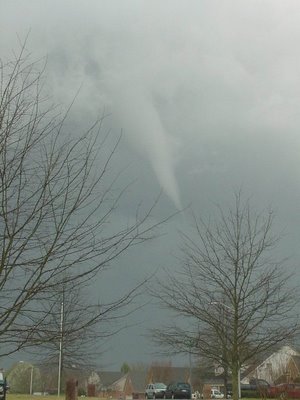
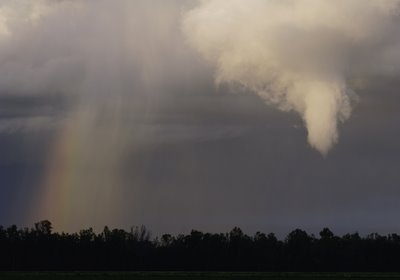 A funnel cloud is a funnel-shaped cloud of condensed water droplets, associated with a rotating column of air and extending from the base of a cloud (usually a cumulonimbus or towering cumulus cloud) but not reaching the ground or a water surface. A funnel cloud is usually visible as a cone-shaped or needlelike protuberance from the main cloud base. Funnel clouds frequently form in association with supercell thunderstorms.
A funnel cloud is a funnel-shaped cloud of condensed water droplets, associated with a rotating column of air and extending from the base of a cloud (usually a cumulonimbus or towering cumulus cloud) but not reaching the ground or a water surface. A funnel cloud is usually visible as a cone-shaped or needlelike protuberance from the main cloud base. Funnel clouds frequently form in association with supercell thunderstorms.
If a funnel cloud touches the ground it becomes a tornado. All tornadoes begin as funnel clouds, but many funnel clouds do not make ground contact and so do not become tornadoes. If there is a dust cloud near the ground beneath the funnel or if the funnel contains dust or debris, rather than just condensed water, a tornado exists. Conversely, some tornadoes may appear only as a debris swirl, with no obvious funnel cloud extending below the rotating cloud base.
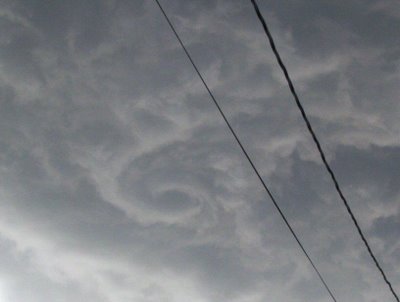
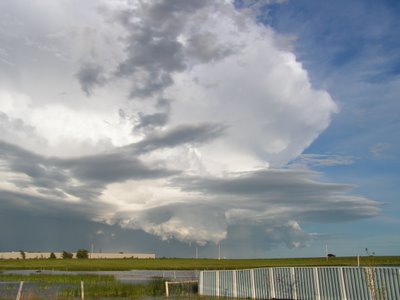
Todd Snyder sent me this photo. It was taken from just west of Calgary, Alberta.
The Crocodiles
 The crocodiles (colloquially called crocs), are large aquatic reptiles that live throughout the Tropics in Africa, Asia, the Americas and Australia. Crocodiles tend to congregate in slow-moving rivers and lakes, and feed on a wide variety of living and dead mammals and fish. Some species, notably the Saltwater Crocodile of Australia and the Pacific islands, have been known to venture far out to sea. They are an ancient lineage, and are believed to have changed little since the time of the dinosaurs.
The crocodiles (colloquially called crocs), are large aquatic reptiles that live throughout the Tropics in Africa, Asia, the Americas and Australia. Crocodiles tend to congregate in slow-moving rivers and lakes, and feed on a wide variety of living and dead mammals and fish. Some species, notably the Saltwater Crocodile of Australia and the Pacific islands, have been known to venture far out to sea. They are an ancient lineage, and are believed to have changed little since the time of the dinosaurs.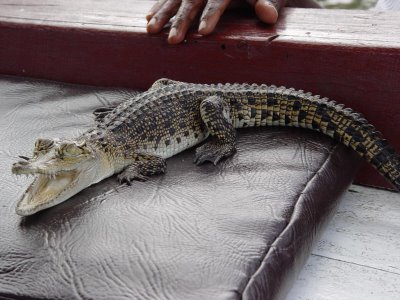 The larger species of crocodiles can be very dangerous to humans. The Saltwater and Nile Crocodiles are the most dangerous, killing hundreds of people each year in parts of South-East Asia and Africa. American Alligators, Mugger crocodiles and possibly the endangered Black Caiman, are also very dangerous to humans. Crocodiles are the leading cause of animal related deaths as of 2001.
The larger species of crocodiles can be very dangerous to humans. The Saltwater and Nile Crocodiles are the most dangerous, killing hundreds of people each year in parts of South-East Asia and Africa. American Alligators, Mugger crocodiles and possibly the endangered Black Caiman, are also very dangerous to humans. Crocodiles are the leading cause of animal related deaths as of 2001. Crocodiles are very fast over short distances, even out of water. They have extremely powerful jaws and sharp teeth for tearing flesh, but cannot open their mouth if it is held closed, hence there are stories of people escaping from the long-snouted Nile Crocodile by holding its jaws shut. Indeed, zoologists will often subdue crocodiles for study or transport by taping their jaws or holding their jaws shut with large rubber bands cut from automobile inner tubes. All large crocodiles also have sharp welters and powerful claws. They have limited lateral movement in their neck, so on land one can find protection by getting even a small tree between the crocodile's jaws and oneself.
Crocodiles are very fast over short distances, even out of water. They have extremely powerful jaws and sharp teeth for tearing flesh, but cannot open their mouth if it is held closed, hence there are stories of people escaping from the long-snouted Nile Crocodile by holding its jaws shut. Indeed, zoologists will often subdue crocodiles for study or transport by taping their jaws or holding their jaws shut with large rubber bands cut from automobile inner tubes. All large crocodiles also have sharp welters and powerful claws. They have limited lateral movement in their neck, so on land one can find protection by getting even a small tree between the crocodile's jaws and oneself.
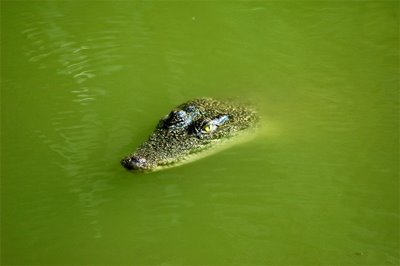
Crocodiles are ambush hunters, waiting for fish or land animals to come close, then rushing out to attack. As cold-blooded predators, they can survive long periods without food, and rarely need to actively go hunting. The crocodile's bite strength is up to 3,000 pounds per square inch, comparing to just 100 psi for a labrador retriever or 350 psi for a large shark. Despite their slow appearance, crocodiles are the top predators in their environment, and various species have been observed attacking and killing big cats such as lions,large ungulates and even sharks. A famous exception is the Egyptian Plover which is said to enjoy a symbiotic relationship with the crocodile. According to unauthenticated reports, the plover feeds on parasites that infest the crocodile's mouth and the reptile will open its jaws and allow the bird to enter to clean out the mouth.

Nature's Mighty Pictures Wants You

Lightning
Clouds are made of many drops of water. When these drops get big and heavy they fall to the earth as rain. While these drops are still in the cloud they have either a + or - charge. When a group of water droplets with a positive charge come near a group of water droplets with a negative charge a spark occurs. We can see this spark. This spark is lightening. The opposite charges attract each other, just as the magnets did.
Sometimes an entire cloud (or at least the majority of the cloud) has a positive or negative charge. When two clouds of opposite charges travel near each other you will be able to see lightening flash between the clouds.

Each year millions of lightening flashes travel from the clouds to the ground. Lightening is very powerful and very dangerous. Many fires are caused by lightening. Lightening can travel through the wires of your home and destroy home appliances.
During a lightening storm you should always seek shelter indoors. If you are in your car, stay in it. If you are outside during a storm, lie down in the lowest area you can find. Never stand under a tree during a lightening storm.
Macro Photography




There is no precise definition of where portrait photography ends and macro photography begins. Macro is the Greek word for large, and it is used for making subjects appear large. A practical way for defining macro photography is by the strength of the lens, or how nearby it can focus. In the old days, a minimum distance of one metre (one diopter) was considered enough, but most lenses will now go to 0.5 metre (2 diopter). Portrait photography ends at about one metre using a 100mm lens. If you want to go any closer, the lens must be mounted further from the camera by means of bellows or extension tubes. One can also make the lens stronger by placing closeup lenses of 1-4 diopters in front.

